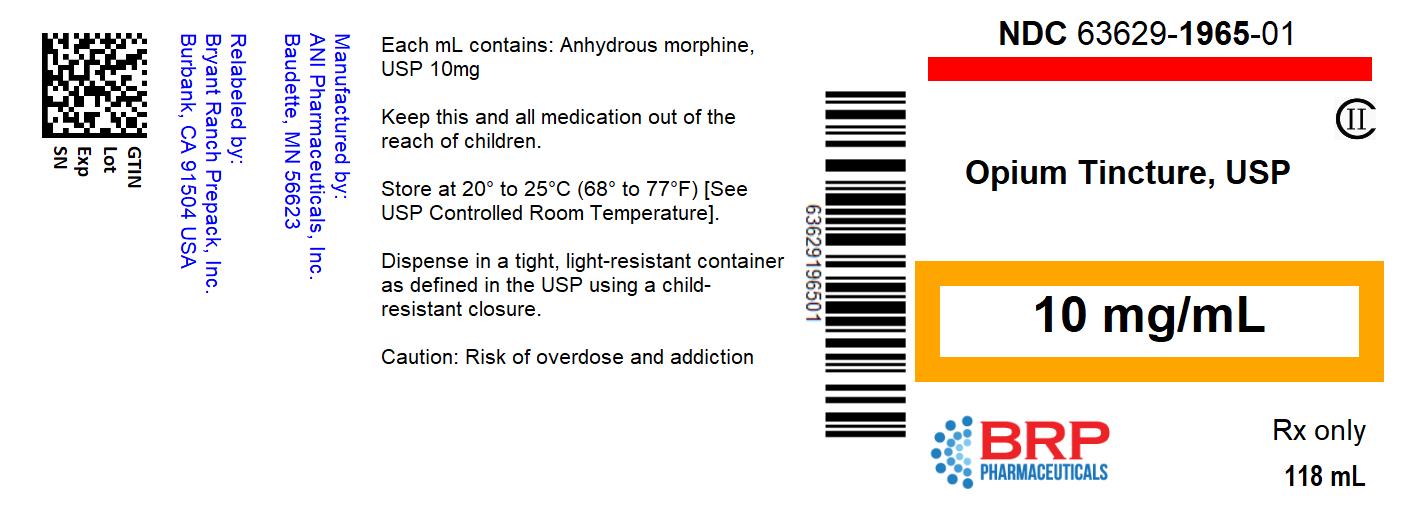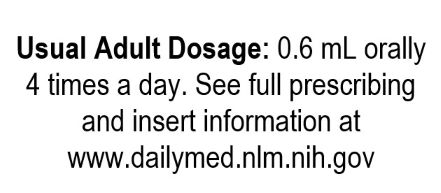OPIUM TINCTURE DEODORIZED- morphine tincture solution
Opium Tincture Deodorized by
Drug Labeling and Warnings
Opium Tincture Deodorized by is a Prescription medication manufactured, distributed, or labeled by Bryant Ranch Prepack. Drug facts, warnings, and ingredients follow.
Drug Details [pdf]
-
DESCRIPTION
Opium Tincture, USP (Deodorized), is for oral administration. It is freed from unpleasant odor or nauseating substances by “denarcotization” with a petroleum distillate. Opium tincture is a clear, reddish-brown hydroalcoholic solution.
Each 100 mL contains 1 g of anhydrous morphine (represents the equivalent of 10 g of Powdered Opium, USP), alcohol, 19%, and water.
Opium has a very characteristic odor and a very bitter taste. The opiates are the most effective and prompt-acting nonspecific antidiarrheal agents. -
CLINICAL PHARMACOLOGY
The opiates act by enhancing tone in the long segments of longitudinal muscle and by inhibiting propulsive contraction of both circular and longitudinal muscles.
Clinical evidence indicates that the analgesic activity of opium preparations is due to their morphine content. Relatively small doses that do not produce significant analgesia are effective in controlling diarrhea. The papaverine content of the mixed alkaloids is too small to have demonstrable spasmolytic activity.
Following oral administration, morphine is well absorbed from the gastrointestinal tract. It is rapidly metabolized following oral administration, however, and plasma levels of unconjugated morphine are lower than those achieved after parenteral administration. Like other narcotic analgesics, opium preparations are metabolized in the liver. Morphine undergoes conjugation with glucuronic acid at the 3-hydroxyl group. Secondary conjugation may also occur at the 6-hydroxyl group to form the 3,6-diglucuronide. Morphine is excreted in the urine mainly as morphine-3-glucuronide and smaller amounts of morphine-3,6-diglucuronide and unchanged drug. Approximately 75% of a dose of morphine is excreted in the urine within 48 hours. - INDICATIONS AND USAGE
- CONTRAINDICATIONS
- WARNINGS
-
PRECAUTIONS
General – Opium should be used with caution in the elderly, in debilitated individuals, and in patients with increased intracranial pressure, cerebral arteriosclerosis, hepatic cirrhosis or liver insufficiency, gastrointestinal hemorrhage, myxedema, emphysema, and bronchial asthma.
Drug Interactions – When preparations containing opium are administered in combination with other drugs, the cautions applicable to each ingredient should be borne in mind. Reduced dosage is indicated in poor-risk patients, in the very young or very old patient, and in those who are receiving other central-nervous system depressants.
Usage in Pregnancy - Pregnancy Category C – Animal reproduction studies have not been conducted with Opium Tincture, USP (Deodorized). It is also not known whether Opium Tincture, USP (Deodorized), can cause fetal harm when administered to a pregnant woman or can affect reproduction capacity. Opium Tincture, USP (Deodorized), should be given to a pregnant woman only if clearly needed.
Nursing Mothers – Caution should be exercised when Opium Tincture, USP (Deodorized), is administered to a nursing woman.
Usage in Children – Safety and effectiveness in children have not been established. See CONTRAINDICATIONS. - ADVERSE REACTIONS
- DRUG ABUSE AND DEPENDENCE
-
OVERDOSAGE
Signs and Symptoms – Symptoms of toxicity are those of morphine and alcohol, such as nausea, vomiting, miosis, cool and clammy skin, respiratory and CNS depression, bradycardia, hypotension, and skeletal muscle flaccidity. Noncardiogenic pulmonary edema may develop after opioid overdose and monitoring of heart filling pressure may be helpful. Ethanol has been demonstrated to cause hypoglycemia in children or adults with limited glycogen stores. In severe overdosage, apnea, circulatory collapse, cardiac arrest, and death may occur.
Treatment – To obtain up-to-date information about the treatment of overdose, a good resource is your certified Regional Poison Control Center. Telephone numbers of certified poison control centers are listed in the Physicians’ Desk Reference (PDR). In managing overdosage, consider the possibility of multiple drug overdoses, interaction among drugs, and unusual drug kinetics in your patient.
Initial management of opioid overdose should emphasize establishment of a secure airway and support of ventilation and perfusion. Meticulously monitor and maintain, within acceptable limits, the patient’s vital signs, blood gases, serum electrolytes, blood glucose, etc. Naloxone antagonizes most effects of opioids. Protect the airway as naloxone may induce vomiting. Since naloxone has a shorter duration of action than opioids, repeated doses may be needed. In patients who abuse opioids chronically, a withdrawal syndrome may be manifest on administration of naloxone. This may include yawning, tearing, restlessness, sweating, dilated pupils, piloerection, vomiting, diarrhea, and abdominal cramps. This syndrome usually abates quickly as the effect of naloxone dissipates.
Absorption of drugs from the gastrointestinal tract may be decreased by giving activated charcoal, which, in many cases, is more effective than emesis or lavage; consider charcoal instead of or in addition to gastric emptying. Repeated doses of charcoal over time may hasten elimination of some drugs that have been absorbed. Since opium tincture can delay gastric emptying, evacuation of the stomach may be beneficial. Safeguard the patient’s airway when employing gastric emptying or charcoal.Monitor for and treat hypoglycemia.
The use of forced diuresis, peritoneal dialysis, hemodialysis or charcoal hemoperfusion has not been established to be beneficial.
- DOSAGE AND ADMINISTRATION
- HOW SUPPLIED
- PRINCIPAL DISPLAY PANEL
-
INGREDIENTS AND APPEARANCE
OPIUM TINCTURE DEODORIZED
morphine tincture solutionProduct Information Product Type HUMAN PRESCRIPTION DRUG Item Code (Source) NDC: 63629-1965(NDC:62559-153) Route of Administration ORAL DEA Schedule CII Active Ingredient/Active Moiety Ingredient Name Basis of Strength Strength MORPHINE (UNII: 76I7G6D29C) (MORPHINE - UNII:76I7G6D29C) MORPHINE 10 g in 1000 mL Inactive Ingredients Ingredient Name Strength ALCOHOL (UNII: 3K9958V90M) WATER (UNII: 059QF0KO0R) Product Characteristics Color BROWN (Reddish-Brown) Score Shape Size Flavor Imprint Code Contains Packaging # Item Code Package Description Marketing Start Date Marketing End Date 1 NDC: 63629-1965-1 118 mL in 1 BOTTLE; Type 0: Not a Combination Product 02/08/2021 Marketing Information Marketing Category Application Number or Monograph Citation Marketing Start Date Marketing End Date Unapproved drug other 02/25/2011 Labeler - Bryant Ranch Prepack (171714327) Registrant - Bryant Ranch Prepack (171714327) Establishment Name Address ID/FEI Business Operations Bryant Ranch Prepack 171714327 REPACK(63629-1965) , RELABEL(63629-1965)
© 2025 FDA.report
This site is not affiliated with or endorsed by the FDA.

